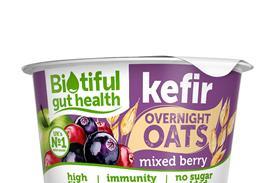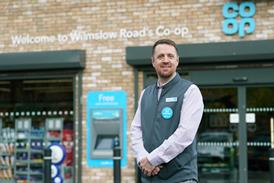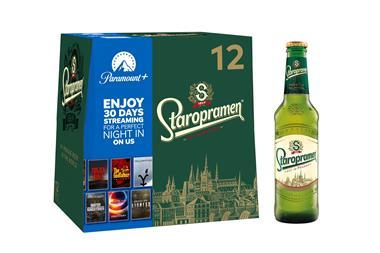You can't open a paper or turn on the TV without reading about growing obesity levels in the UK, and consumers are responding. Although low-fat foods have been on the market since the first burst of diet culture in the 1960s, the need to eat more healthily and watch your weight has never been more prominent.
Department of Health research reveals that if current trends continue, 6.6 million men will be clinically obese by the end of the decade, up from 4.3 million in 2003. The number of obese women is set to rise from 23% in 2003, about 4.8 million, to 28% of the population - almost six million women.
The low-fat and low-calorie markets reflects this. According to Mintel, the total processed low-fat food market has seen dynamic growth since the end of the 1990s, with sales rising 37% to reach £188bn between 2000 and 2004. The multiples, Co-ops and independents have seen reduced fat and reduced calorie foods increase 2.4% to £169m. It also found that about seven in 10 households buy products in the reduced fat and reduced calorie market.
So how best to tap into this growing audience? The longest-established categories are the most popular, led by salad accompaniments, yogurts and spreads. However, ready meals and cooking sauces have also made some progress. Convenience retailers have also gained from the development of more products in the impulse sector, such as cakes and snacks. The TNS Family Food Panel in 2005 found that health continues to grow in significance; when people select a snack it's the primary consideration 12% of times.
Brands developed purely for the low-fat and diet sector are gaining popularity and Weight Watchers now occupies a spot in the top 20 grocery brands. Its core licensed products and the Weight-Watchers from Heinz range are worth £136m and £103m respectively. Licensing marketing manager Jennie Dettmer says: "Some of the sales come from our members but the appeal is broader in that someone who isn't counting points would still identify WeightWatchers as a strong diet offering."
Other WeightWatchers success stories in convenience stores include staples such as bread and impulse buys such as cake twin-packs and sausage rolls.
Mark Rooza, sales director from WeightWatchers licensee Anthony Alan Foods, says: "The consumers of Weight Watchers products are typically female, and when they shop in convenience stores it tends to be more for themselves rather than the general family shop where they buy the same products week in, week out. As such, sales of individual and twin-pack chilled pastries seem to be going better in the high street than the multiples."
Low-fat sandwiches and wraps reflect the strong growth in the c-store market. TNS found that for every premium sandwich sold in the year to April 2006, approximately four healthy ones flew off the shelves. Of this, independents scooped 2.4% of the market.
Unlike the multiples, independents are less likely to develop own-brand sandwich ranges. Gibson Foods make WeightWatchers' branded sandwiches and chairman Edward Gibson says shoppers respond to recognised labels.
He says: "We have dealt with customers who have removed their own healthy eating offering and replaced it with WeightWatchers because they don't see the point in stocking their own version when there's a well-recognised brand they can tap into."
If consumers aren't choosing a specialised brand such as Weight-Watchers, they are looking for healthier or lighter versions of their usual purchases.
Seasons' eatings
The low-fat sector is increasing in popularity throughout the year, but there are still seasonal trends in dieting and diet foods. The three main peak periods are the New Year, post-Easter in April and May, and the pre-festive season in September.
WeightWatchers has tapped into the September peak with a burst of promotional activity planned for Budgens stores. It includes price promotions and the Great Local Deals flyer and website link-ups. There is another campaign planned for the New Year.
However, manufacturers are having to respond to the consumer trend towards overall healthier eating.
Unilever UK Foods has recently relaunched its weight loss brand Slim Fast to include more natural products with new packaging and a £6.5m marketing campaign. Alongside its traditional ready-to-drink milkshake, new products include real fruit smoothies and soups.
Abu Mallick, senior planner at brand consultancy Geometry, believes the market for low-fat products is starting to diversify beyond the Weight Watchers and Slim Fast brand names towards new market entrants which are adding the human touch to marketing.
He says: "If you look at two brands in the market - WeightWatchers and Skinny Cow ice-cream - both are in the low-fat diet segment but WeightWatchers has a more disciplined feel to watching your weight. A brand like Skinny Cow liberates consumers from that - it is still a low-fat food but presents itself more indulgently and psychologically doesn't make the consumer feel imprisoned."
United Biscuits UK (UBUK) has responded to consumer demand for premium brands to be healthier by removing the hydrogenated vegetable oil from its McVitie's, KP and Jacob's ranges and reducing the fat in Hula Hoops, Skips and Mini Cheddars.
UBUK head of strategic projects Alice Cadman says: "It isn't all about low-fat products but offering consumers a range of products that have more wholesome ingredients."
The message to consumers is clear: eat healthily and lower your fat intake. If that happens, as the country's waistlines shrink the low-fat food market will just keep on growing.
Department of Health research reveals that if current trends continue, 6.6 million men will be clinically obese by the end of the decade, up from 4.3 million in 2003. The number of obese women is set to rise from 23% in 2003, about 4.8 million, to 28% of the population - almost six million women.
The low-fat and low-calorie markets reflects this. According to Mintel, the total processed low-fat food market has seen dynamic growth since the end of the 1990s, with sales rising 37% to reach £188bn between 2000 and 2004. The multiples, Co-ops and independents have seen reduced fat and reduced calorie foods increase 2.4% to £169m. It also found that about seven in 10 households buy products in the reduced fat and reduced calorie market.
So how best to tap into this growing audience? The longest-established categories are the most popular, led by salad accompaniments, yogurts and spreads. However, ready meals and cooking sauces have also made some progress. Convenience retailers have also gained from the development of more products in the impulse sector, such as cakes and snacks. The TNS Family Food Panel in 2005 found that health continues to grow in significance; when people select a snack it's the primary consideration 12% of times.
Brands developed purely for the low-fat and diet sector are gaining popularity and Weight Watchers now occupies a spot in the top 20 grocery brands. Its core licensed products and the Weight-Watchers from Heinz range are worth £136m and £103m respectively. Licensing marketing manager Jennie Dettmer says: "Some of the sales come from our members but the appeal is broader in that someone who isn't counting points would still identify WeightWatchers as a strong diet offering."
Other WeightWatchers success stories in convenience stores include staples such as bread and impulse buys such as cake twin-packs and sausage rolls.
Mark Rooza, sales director from WeightWatchers licensee Anthony Alan Foods, says: "The consumers of Weight Watchers products are typically female, and when they shop in convenience stores it tends to be more for themselves rather than the general family shop where they buy the same products week in, week out. As such, sales of individual and twin-pack chilled pastries seem to be going better in the high street than the multiples."
Low-fat sandwiches and wraps reflect the strong growth in the c-store market. TNS found that for every premium sandwich sold in the year to April 2006, approximately four healthy ones flew off the shelves. Of this, independents scooped 2.4% of the market.
Unlike the multiples, independents are less likely to develop own-brand sandwich ranges. Gibson Foods make WeightWatchers' branded sandwiches and chairman Edward Gibson says shoppers respond to recognised labels.
He says: "We have dealt with customers who have removed their own healthy eating offering and replaced it with WeightWatchers because they don't see the point in stocking their own version when there's a well-recognised brand they can tap into."
If consumers aren't choosing a specialised brand such as Weight-Watchers, they are looking for healthier or lighter versions of their usual purchases.
Seasons' eatings
The low-fat sector is increasing in popularity throughout the year, but there are still seasonal trends in dieting and diet foods. The three main peak periods are the New Year, post-Easter in April and May, and the pre-festive season in September.
WeightWatchers has tapped into the September peak with a burst of promotional activity planned for Budgens stores. It includes price promotions and the Great Local Deals flyer and website link-ups. There is another campaign planned for the New Year.
However, manufacturers are having to respond to the consumer trend towards overall healthier eating.
Unilever UK Foods has recently relaunched its weight loss brand Slim Fast to include more natural products with new packaging and a £6.5m marketing campaign. Alongside its traditional ready-to-drink milkshake, new products include real fruit smoothies and soups.
Abu Mallick, senior planner at brand consultancy Geometry, believes the market for low-fat products is starting to diversify beyond the Weight Watchers and Slim Fast brand names towards new market entrants which are adding the human touch to marketing.
He says: "If you look at two brands in the market - WeightWatchers and Skinny Cow ice-cream - both are in the low-fat diet segment but WeightWatchers has a more disciplined feel to watching your weight. A brand like Skinny Cow liberates consumers from that - it is still a low-fat food but presents itself more indulgently and psychologically doesn't make the consumer feel imprisoned."
United Biscuits UK (UBUK) has responded to consumer demand for premium brands to be healthier by removing the hydrogenated vegetable oil from its McVitie's, KP and Jacob's ranges and reducing the fat in Hula Hoops, Skips and Mini Cheddars.
UBUK head of strategic projects Alice Cadman says: "It isn't all about low-fat products but offering consumers a range of products that have more wholesome ingredients."
The message to consumers is clear: eat healthily and lower your fat intake. If that happens, as the country's waistlines shrink the low-fat food market will just keep on growing.






















No comments yet